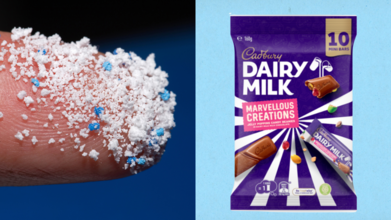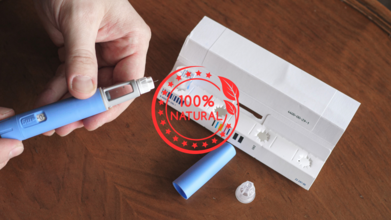- Health Conditions A-Z
- Health & Wellness
- Nutrition
- Fitness
- Health News
- Ayurveda
- Videos
- Medicine A-Z
- Parenting
- Web Stories
How Does Drinking Rose Tea Benefits Your Health?

Rose Tea (Credit: Canva)
Roses have always been cherished for their beauty, fragrance, and medicinal properties. However, recent research has shown that they also have numerous health benefits. One of its products Rose tea offers several benefits and is naturally caffeine-free. This aromatic herbal beverage is made from the fragrant petals and buds of rose flowers. This article lists the health benefits of rose tea.
Here Is Why You Should Drink Rose Tea
Many people rely on caffeinated beverages like coffee and tea for an energy boost and mental stimulation. However, many people feel the side effects of caffeine such as headaches, sleep and heart problems. Moreover, rose tea can also contribute significantly to daily fluid intake. Proper hydration helps combat fatigue, prevent headaches, and support skin health. Moreover, drinking water-rich beverages like rose tea can aid weight management by boosting metabolism and promoting a feeling of fullness when consumed before meals.Rose tea is full of antioxidants, particularly polyphenols such as gallic acid, anthocyanins, and quercetin. These compounds combat oxidative stress caused by free radicals, which can contribute to ageing and chronic illnesses like heart disease and cancer. Research even suggests that the antioxidant content of some rose teas rivals that of green tea.
Rose tea can also prove to be a natural remedy for cramps. Traditional medicine often recommends rose tea for menstrual pain relief. A study conducted on teenage girls in Taiwan found that drinking rose tea reduced menstrual cramps and improved emotional well-being. While more research is needed, these findings suggest that rose tea could be a natural alternative to conventional pain relief methods.
Moreover, this herbal tea is also associated with antibacterial properties, improved digestion, and stress relief. However, many purported benefits, such as enhanced heart health and anti-inflammatory effects, stem from studies on concentrated rose extracts, not the tea itself. It’s important to distinguish rose tea from rosehip tea, the latter being rich in vitamin C.
How To Prepare Rose Tea?
Making rose tea is simple and customizable. You can start by using fresh petals or dried rose buds but you need to ensure that they are pesticide-free. If you’re making tea from fresh petals, you need about 2 cups of washed petals. Simply boil them with 3 cups (700 ml) of water for about 5 minutes. Once finished, strain the tea into cups and enjoy.If you’re using dried petals or buds, place 1 tablespoon of either in a cup and steep them in boiling water for 10–20 minutes. Different brands may recommend specific water temperatures and brewing times. Enjoy the tea plain or with a touch of honey for added sweetness.
Cadbury Australia Chocolate Recall: Why Your Body Is Already Home To Over 39,000 Microplastics And How To Cut Them Down

Australians who recently stocked up on Cadbury’s Marvellous Creations Jelly Popping Candy Beanies might want to check their cupboards. Cadbury Australia has recalled its 10-piece share bags (160g) after Food Standards Australia New Zealand (FSANZ) warned they may contain plastic.
The recall affects products with a best-before date of May 21, 2026, sold at Coles, Woolworths, Drakes, The Reject Shop, IGA, and other independent retailers.
The advice is clear: do not eat it. Return it for a refund, and if you have already consumed them, seek medical advice if you feel unwell. Cadbury assures that no other products are affected.
But the uncomfortable truth is that even if you avoid this recalled chocolate, there is still a good chance you are consuming plastic every single day. Wonder why I would say that? Read on...
While we all love a wholesome, clean meal, full of steamed veggies, a slice of grilled fish, and a glass of water, the burning question is if it is really clean. Invisible to the naked eye, lurking on that dinner plate could be thousands of microscopic plastic particles. From our kitchens to our bedrooms, plastic reigns supreme and it looks almost impossible to get rid of it. Anyway, let us get into the nitty-gritty of how we are directly or indirectly surrounded by plastic and what happens to our bodies.
The Effects of Microplastics on the Human Body
Plastic pollution has long been the most hated when it comes to environmental damage, but now it has got a more personal twist—it is in us. Microplastics, the tiny pieces and fibres that flake off larger plastic items or are manufactured at minuscule sizes, have stealthily infiltrated our food, our air, and even our bodies.
According to current research, the average person unknowingly ingests anywhere between 39,000 and 52,000 microplastic particles each year. And if you include breathing them in? The number climbs higher. We are inhaling and swallowing tiny plastic bits from seafood, vegetables, salt, and even the humble protein powder you down after yoga.
Also Read: Breast Milk Ice Cream Hits The Shelves, But Do Adults Really Need It?
The Pathways of Microplastics to the Human Body
How do these microplastics get in? The main pathway is oral intake—what we eat and drink. Microplastics have seeped into agricultural soil via sewage sludge, compost, and plastic mulching. From there, they travel up through plant roots and into fruits and vegetables. If you thought organic carrots were safe, they are not. If they are grown in contaminated soil, they are just organic carrots with sides of polyethylene.
Your Favourite Takeway
Takeaway food does not get off the hook either. Those aesthetic-looking plastic containers? They shed microplastics too. According to a report published in ACS Publications, if you are the kind to order in 4–7 times a week, you could be chomping down on an extra 12 to 203 microplastic fragments just from the packaging alone.
The Air You Breathe
Breathing is not safe either unless you have figured out how to inhale filtered mountain air all day. Most of the plastic in the air comes from roads like tyre dust and synthetic fibres floating invisibly around us. These tiny particles find their way into our lungs, and interestingly, scientists have found that the ones lodged deep in lung tissue are even smaller than what is floating in the atmosphere.
Skin-Deep Exposure
Skin contact, although less of a direct route, still adds to the exposure. Think face creams, scrubs with plastic microbeads, or even that trusty phone case. While our skin usually holds the line, it is not foolproof. Plastics can cling to us, ride into our systems via hand-to-mouth contact, or just hang around, increasing the risk of further exposure.
The Truly Unsettling Part?
Microplastics have been detected in human blood, liver, lungs, spleen, breast milk, and even the placenta. They have become part of us, literally. While the full scope of their long-term impact is still being researched, we already know they can cause oxidative stress, mess with our metabolism, interfere with the immune system, and wreak havoc on reproduction and development.
Small, mindful changes can help reduce your exposure
- Ditch the plastic water bottles and go for stainless steel or glass. Stop microwaving food in plastic because heat produces chemicals like BPA to leach into your food.
- Choose ceramic over plastic for food storage. Swap plastic chopping boards and utensils for hardwood and metal alternatives.
- Even your skincare routine could use a detox. Get mineral-based sunscreens and plastic-free moisturisers.
- Avoid detergent pods, scrutinise your tea bags, and maybe give your takeaway habit a little break.
Breast Milk Ice Cream Hits The Shelves, But Do Adults Really Need It?

Credits: Frida, Canva
Have you heard yet? The Breast milk ice cream by OddFellows and Frida is the hottest talk of the town. While the ice cream is actually not made with real breast milk, the taste is said to mimic it. It is a bit sweet, a bit salty and has hints of honey with a "dash of colostrum", states Frida's website. According to Frida's official press release, the company wanted to answer the question that everyone "secretly wondered": What does breast milk actually taste like?
The Press Release read, as published by People, "The ice cream will be a pitch-perfect representation of the sweet, creamy, nutrient-packed goodness we’ve all wanted to try but have been afraid to ask about. It will include some of the same nutrients — fats (Omega-3 brain fuel!), carbs (energy-boosting lactose), important vitamins (iron, calcium, vitamins B and D, and zinc), plus lots of H2O for hydration."
While the ice cream may not have been made from actual breast milk, many adults consume breast milk for purported health benefits. As per a 2015 study published in the Journal of the Royal Society of Medicine, adults are buying breast milk from online market. It is marketed as "super food" and has emerged as a craze among adults.
The study notes: "While breast milk has long been promoted as optimal for infant nutrition, among CrossFit, BodyBuilding, Palaeo and other fitness communities, fetishists, chronic disease sufferers and even foodies, breast milk is in demand. In the UK, breast milk ice cream is for sale. In the USA, a lollypop company sells a breast milk-flavoured sweet. Primarily, though, the milk is sold in its raw state, ready to drink."
But, is it really that necessary for adults to consume this "super food" made for the babies? Do fitness freak really need breast milk for muscles? To know answers to these questions, we spoke to Ms Edwina Raj, Head of Services, Clinical Nutrition & Dietetics at Aster CMI Hospital, Bengaluru.
Raj says that there is no scientific evidence that breast milk provides unique muscle gain or recovery benefits for adults beyond what regular protein sources offer.
Is Breast Milk For Adults?
"While it [breast milk] contains proteins, carbohydrates, fats, and growth factors ideal for infants, the protein content is relatively low compared to whey, casein, or plant-based protein powders commonly used by athletes. Claims that breast milk boosts performance often stem from its association with growth-promoting compounds for babies, but these do not have the same impact on fully developed adult bodies," explains Raj.
For adults, the muscle gain actually relies on adequate protein intake, balanced diet and proper training.
Do Adults REALLY Need This "Super Food"?
The main claim that makes breast milk so enticing even to adults is that it provides all essential nutrients for one to sustain. However, explains Raj, the nutrients in breast milk can be matched. Though, she agrees that it cannot mimic the benefits of immunonutrients. However, Raj says that other key components like proteins, healthy fats, carbohydrates, vitamins, minerals, and beneficial compounds are all readily available in a balanced diet.
For example, high-quality protein from eggs, dairy, lean meats, legumes, and whey supplements can exceed breast milk’s protein content, while omega-3 fatty acids from fish, flaxseeds, and walnuts offer equal or greater heart and brain benefits. Vitamins and minerals found in breast milk can be obtained from fruits, vegetables, whole grains, and fortified foods. Even immune-supporting and gut-friendly compounds can be obtained through probiotics, prebiotics, and nutrient-rich foods.
Raj says, "[Breast milk] it doesn’t offer any essential nutritional benefits to healthy adults that they can’t get from regular foods or supplements. Its proteins, healthy fats, vitamins, and minerals can all be obtained from a balanced diet, and the immune-boosting antibodies in breast milk are most effective for developing infant immune systems, not fully matured adult ones."
Hygiene Issues
For products like breast milk ice cream, strict hygiene and safety checks are essential to ensure it’s safe for adult consumption.
Raj notes that the donor must be screened for infectious diseases such as HIV, hepatitis B and C, syphilis, and other transmissible illnesses, similar to blood donation protocols.
Although breast milk flavoring ingredient may be of small amount but the milk should be collected using sterile equipment, handled with gloved hands, and stored at safe temperatures to prevent bacterial growth.
"Pasteurization is crucial to kill harmful bacteria and viruses without significantly altering nutritional content. Production facilities must follow food safety regulations, including contamination control, regular microbial testing, and proper labelling," she says.
Consumers should only source such products from regulated, tested suppliers, as untested breast milk can carry serious health risks for adults.
Talking about the breast milk flavoured ice cream, she says, "Breast milk flavored ice cream can shock the consumer yet cannot be superior to what a balanced adult diet can provide, and the immune-boosting properties mainly benefit infants, for its benefit in adults are yet to be studied."
"As long as it’s made under strict safety standards, it can be a quirky treat but not a game-changer in adult nutrition," she says.
This Naturally Occurring Molecule May Have Ozempic-like Benefits Without The Side Effects

Credits: Canva
What if we tell you that a naturally occurring molecule can do wonders like Ozempic, but without the side effects. Hard to believe, isn't it? However, Stanford Medicine researchers have found a molecule that acts similar to semaglutide, by suppressing appetite and reducing body weight. The trials on animals have also shown that it worked without some of the drug's side effects, including nausea, constipation and significant loss of muscle mass.
The paper was published on March 5 in Nature, and led by Laetitia Coassolo, PhD, Kartin Svensson, assistant professor of pathology.
What Is This Naturally Occurring Molecule?
This newly discovered molecule is BRP. This acts, though, in a separate pathway, but has similar metabolic effects. It can activate different neurons in the brain and offer a more targeted approach to body weight reduction.
Stanford Medicine's release quoted Svensson, PhD, who explained, "the receptors targeted by semaglutide are found in the brain but also in the gut, pancreas and other tissues. That’s why Ozempic has widespread effects including slowing the movement of food through the digestive tract and lowering blood sugar levels. In contrast, BRP appears to act specifically in the hypothalamus, which controls appetite and metabolism.”
Svensson has also co-founded a company to launch clinical trials of the molecule in humans in the near future.
How Was The Study Conducted?
This study would not have been possible without the help of AI, notes the release. Researchers used AI to sift through dozens of proteins in a group called prohormones.
Prohormones are molecules that do not do anything on their own at first. They become active only after being cut into smaller pieces, called peptides, by other proteins. Some of these peptides then act as hormones, controlling important functions in the body, such as energy use in the brain and other organs.
Each prohormone can be cut in different ways, producing many possible peptides. Among these, only a few actually work as hormones, while most are just byproducts of protein breakdown. Traditional lab methods make it hard to find the useful peptides in this mix.
The researchers focused on an enzyme called prohormone convertase 1/3, which cuts prohormones at specific points in the amino acid chain. This enzyme has been linked to obesity in humans. One of the peptides it produces is GLP-1, which helps control appetite and blood sugar levels.
The drug semaglutide works by mimicking GLP-1. The team wanted to see if there were other peptides from this enzyme that also play a role in energy metabolism.
To do this, they created a computer program called Peptide Predictor. Instead of manually sorting through proteins, the program scanned all 20,000 human protein-coding genes to find likely cutting sites for prohormone convertase 1/3. They focused only on proteins that are secreted outside the cell, a key feature of hormones, and that had at least four cutting sites. This narrowed the list to 373 prohormones.
The program predicted that these could produce 2,683 unique peptides. The team then looked at those most likely to act in the brain and tested 100 of them, including GLP-1, on lab-grown nerve cells.
GLP-1 increased cell activity about three times compared to normal cells, as expected. But one small peptide, just 12 amino acids long, increased activity tenfold. They named it BRP, based on the name of its parent protein BRINP2.
What Did The Result Reveal?
Tests on lean mice and minipigs showed promising results. An injection of BRP before feeding reduced food intake by up to 50% over the next hour. In obese mice, daily injections for two weeks led to an average weight loss of 3 grams, mostly fat, while untreated mice gained about 3 grams. The treated mice also had better blood sugar control.
Importantly, BRP did not change the animals’ movement, water intake, anxiety levels, or digestion. It also works through different brain and body pathways than GLP-1 or semaglutide, which could make it useful for people who do not respond well to those drugs.
What's Next?
Researchers now want to find the exact cell receptors BRP binds to and figure out how to make its effects last longer in the body. If it proves safe and effective in humans, BRP could offer a new option for treating obesity.
The study was a collaboration between scientists at the University of California, Berkeley, the University of Minnesota, and the University of British Columbia.
© 2024 Bennett, Coleman & Company Limited

